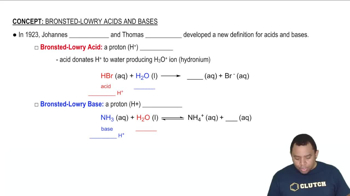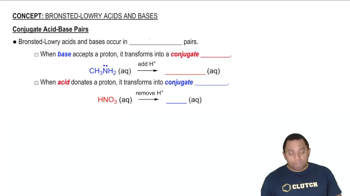Here are the essential concepts you must grasp in order to answer the question correctly.
Acid-Base Theory
Acid-base theory explains the behavior of acids and bases in chemical reactions. According to the Brønsted-Lowry theory, an acid is a proton donor, while a base is a proton acceptor. The strength of a base is determined by its ability to accept protons, which is influenced by the stability of the resulting conjugate acid.
Recommended video:
Bronsted-Lowry Acid-Base Theory
Conjugate Acid-Base Pairs
Conjugate acid-base pairs consist of two species that differ by the presence of a proton. When a base accepts a proton, it forms its conjugate acid, and the strength of the base can be inferred from the stability of its conjugate acid. A weaker conjugate acid indicates a stronger base, as it is less likely to donate a proton back.
Recommended video:
Conjugate Acid-Base Pairs
Electronegativity and Basicity
Electronegativity is the tendency of an atom to attract electrons in a bond. In the context of basicity, a more electronegative atom will hold onto its electrons more tightly, making it less likely to accept protons. Therefore, when comparing bases, the one with the less electronegative atom is typically the stronger base, as it can more readily accept protons.
Recommended video:
 Verified step by step guidance
Verified step by step guidance


